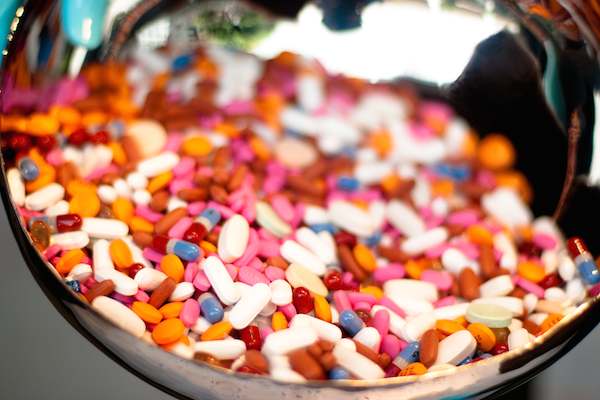
[Image above] Credit: Pranjal Mahna; Flickr CC BY-NC-ND 2.0
According to the Centers for Disease Control and Prevention, 44 people die daily from prescription opioid overdose in the United States alone.
The majority of those deaths involve opioid analgesics, a class of drugs that includes oxycodone, fentanyl, and methadone. Abuse of this class of drugs is on the rise—overdose deaths involving opioid analgesics increased 21% during 2006–2010.
But it’s not just a problem of popping pills. According to a 2014 presentation to the Senate Caucus on International Narcotics Control, “They are most dangerous and addictive when taken via methods that increase their euphoric effects (the ‘high’), such as crushing pills and then snorting or injecting the powder, or combining the pills with alcohol or other drugs.”
A solution to this problem might soon come from an unlikely source—ceramics.
Materials science company Lucideon (Stoke-on-Trent, United Kingdom) has developed a new strategy that can prevent drug abusers from using those dangerous high-increasing methods quoted above. The company’s ceramic pills are much more structurally robust than traditional pharmaceuticals, making them very difficult to crush or to dissolve into alcohol or other solvents.
Because the ceramic pills are porous, Lucideon can embed pharmaceutical drugs within the pills’ pores. Those pores then release the drug into the body once the pill is ingested, a development the company calls inorganic controlled release technology, iCRT.
Made of a silica-based material, the pills also have a high melting point, a feature that further deters drug abuse via injection because heating to such high temperatures would in the process destroy the drug’s activity.
If commercialized, the technology could offer an unlikely ally to effectively fight opioid painkiller abuse.
Lucideon fabricates the silica pills with a proprietary method that creates a nanoporous material that confers tight control over dose release rate, says Gemma Budd, business manager of Lucideon Healthcare, in a phone interview. The process can generate pores that are 2–5 nm in diameter within the ceramic matrix.
“Ceramics can be very porous,” Tony Kinsella, chief executive of Lucideon, says in an article in The Telegraph. “We put the drug into the pores of the ceramic, which means it can’t dissolve in whisky. It will only come out when the material hits the stomach.”
Although the company won’t disclose details of its proprietary manufacturing technique, Budd says it’s a sol gel process—a benefit for manufacturing because it doesn’t require high temperatures, which can destroy drug activity. Drugs can be loaded into pores of the material before or after processing, depending on the drug formulation itself or the intended therapeutic outcome.
According to Budd, Lucideon believes that controlled charges on the pore surfaces make it much easier for the drug to be released in the intended environment within the body rather than in solvents such as alcohol.
Lucideon has tested the technology with several different drug formulas, all of which seem to be compatible with the porous ceramic delivery system, Budd says. Additionally, as a materials science company, Lucideon can tailor its silica-based formula for optimization with specific drug chemistries as needed, opening up wide avenues within the pharmaceutical industry.
Taken orally, ceramic pills release their embedded drugs within the body, and then the pill itself passes through the gastrointestinal tract. Although the ceramics do break down somewhat in the intestinal tract, Lucideon doesn’t expect that this degradation will be problematic because silica is considered biosafe, Budd says.
Further, the company will soon establish biocompatibility profiles for its ceramic pills—Lucideon is about to enter into clinical trials with one of its pharmaceutical partners. But, Budd points out, materials with similar chemical profiles are already approved for pharmaceutical use.
Although the material’s properties make the pills so useful in preventing drug abuse, those properties are inherent to the material itself—Lucideon is simply harnessing those properties for new applications and new ways of thinking about the material, Budd says.
And although Lucideon has discovered a new niche for this material as an abuse deterrent technology, the fundamental driver of the development is controlled release.
That means that the ceramic pills have many possible additional applications in the pharmaceutical world, including improving dissolution of low-solubility drugs and more tightly controlling drug release. That control can dictate how and where drugs are released into the body, for instance, using pH-controlled release. Targeting a drug for release in an acidic environment like the stomach, for example, can increase drug efficiency and decrease side effects.
In addition, multiple drugs that are otherwise chemically incompatible can be combined together for simultaneous delivery to the body in ceramic pills. “One of the things we’re looking at now is how this tech could shield drugs from one another,” Budd says.
The pills’ potential reach extends beyond the pharmaceutical industry, however. Another promising market for controlled release technology is for fragrances, with applications such as air fresheners and laundry, Budd says. “Lucideon is a materials science company, so we’ll follow the material and see what it can do—we’re not married to a particular industry,” Budd says.
Author
April Gocha
CTT Categories
- Biomaterials & Medical
- Manufacturing
- Material Innovations
- Nanomaterials


